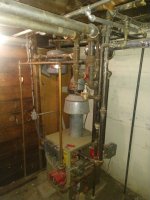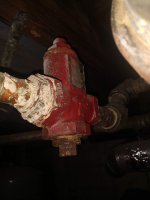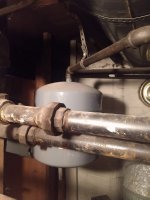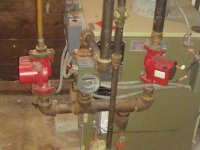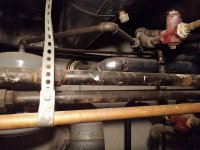Too much air in the system would result in air-locking of the zone resulting in zero flow, and no heat. Is that's what's going on? If there is enough flow to heat all zones you're really good to go- an air scoop or vent anywhere on the system will eventually purge the remaining air.
So far you have only mentioned noise, which can have multiple causes, not all of which would be related to air in the system.
The expansion tank being on the end of a length of pipe is fine. Where it taps in to the system would ideally be near the intake side of the pump(s), to help lower the potential for impeller cavitation, which does create noise. But improper/insufficient system pressure also contributes to pump cavitation (and the associated cavitation noise).
The height from the basement floor to the top of the system is irrelevant. The vertical distance between the pressure gauge and the top of the system is what matters. The pressure needs to be high enough to keep water at the top of the system with or without the pumps running. The static (no pumping) pressure needed when the system is tepid or cool would be the vertical distance from the gauge to the top of the system measured in feet, x 0.433 psi per foot. To make up for the pressure differences induced by the pumps usually only takes an additional 3 psi. For most 1-2 story houses 12psi covers that with some margin, and there it nothing to be gained by setting it lower than that. Bumping it even a few psi higher helps reduces cavitation risk on sub-optimally plumbed pumps & expansion tanks.
So, if the distance between the basement floor and the top of the system is 17', and the gauge is located 3' above the floor, that is 14' from where the pressure is measured and the top, that' would be 14' x 0.433 psi/ft= 6 psi, add 3 psi for pumping pressures only brings it to a 9 psi minimum. So the system could/should be pressurized to 12 psi at the gauge. The air side of the expansion tank should also be pumped up to 12 psi prior to pressurizing the system, even though it's a few feet above the gauge location. Measure the air pressure while it's on the system- it should pretty much match the pressure measured gauge on the boiler, but its fine if it's ~1 psi lower (since it's at a higher elevation). If it's lower than that it doesn't have enough air charge. If that's an issue say so and I'll walk you through how to get the charge correct without pulling it from the system.
If the system pressure is too high you risk hitting a pressure high enough for the pressure relief safety valve to open and dump scalding hot water when the system is at full hot, which is usually set to 30 psi on residential systems. So unless there is a demonstrated need, keep the tepid/cool pressure at no more than 15 psi, to allow for more expansion when the water is fully hot.
Air bleeders on the baseboards in the attic are plenty good for bleeding the system. With the system off and relatively cool when you open a bleeder does air come out? A sputtering of air plus water? Water only?
Usually the air will migrate to the top-most zone, and in a system that has been running awhile (days, weeks), bleeding just one of the top radiators until it's running water-only will usually be enough. This normally only needs to be done after the system has been opened up for re-work (say, installing a vent or air scoop), or drained then re-filled. Most systems don't need to be drained and re-filled annually, but blowing out the accumulated sludge at the bottom of a cast iron system every year before the heating season is a good idea. Cracking open the boiler drain and adding water to the system without fully losing pressure or going over 25 psi (to avoid tripping the pressure relief) until the water coming out the boiler drain looks pretty clean is enough- no need to replace the radiation loop water annually.

